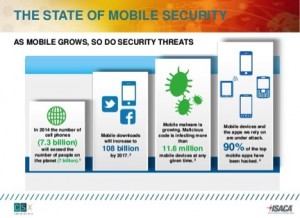There exist many types of malware targeting mobile devices. And with the proliferation of mobile phones over the past decade, malware developers have dramatically ramped up their efforts to create and distribute malicious software to the cell phone community. Unsurprisingly perhaps, financial attacks are the single largest category of malware. According to a recent article by Ori Bach at SecurityIntelligence.com, about 30% of all extant malware is built for the purpose of stealing financial information. Other popular categories include stealing personal information, keystroke logging, deploying cryptographic ransomware, or opening the phone up to remote control of cameras, microphones, or call eavesdropping.
How’s It Work?
The susceptibility of mobile phones to malware is driven not only by the increasing enthusiasm of developers, but also the generally poor security habits of users. Failure to use robust passwords, thoughtlessly accessing public Wi-Fi networks, and willingly clicking on text links all contribute to the inadvertent downloading of malware onto mobile phones. Also, to exacerbate an already bad situation, many mobile users jailbreak or root their phones, which, among other effects, renders their inherent security ineffective.
Particularly nefarious is an app that can make your phone appear to be turned off while still remaining powered on, thus allowing remote hacking. This app can even simulate the “slide to power off” screen. But when activated by the user, instead of actually powering down, the phone goes into low power mode, which leaves the baseband processor running. With this system still powered on, the phone is still able to receive commands, such as one telling the microphone to turn on, or even to record calls and transmit them to an unauthorized third party.
The Bottom Line
Aside perhaps from a loss of personal financial information, the most severe consequence of a malware attack is almost certainly the interception and/or redirection/recording of personal (possibly confidential) phone calls. And while the QS1 cannot stop the inadvertent installation of malware/spyware on a mobile phone (that can only be accomplished through the use of good security habits, e.g., not clicking on unknown text links, not connecting to insecure pubic Wi-Fi networks, etc.), it can secure the phone against malware apps that try to remotely access the phone’s speakers, cameras, or microphones. And its unparalleled encryption capabilities will ensure that should any voice calls be intercepted, the resulting stream of strongly encrypted data will be useless to the attacker.






